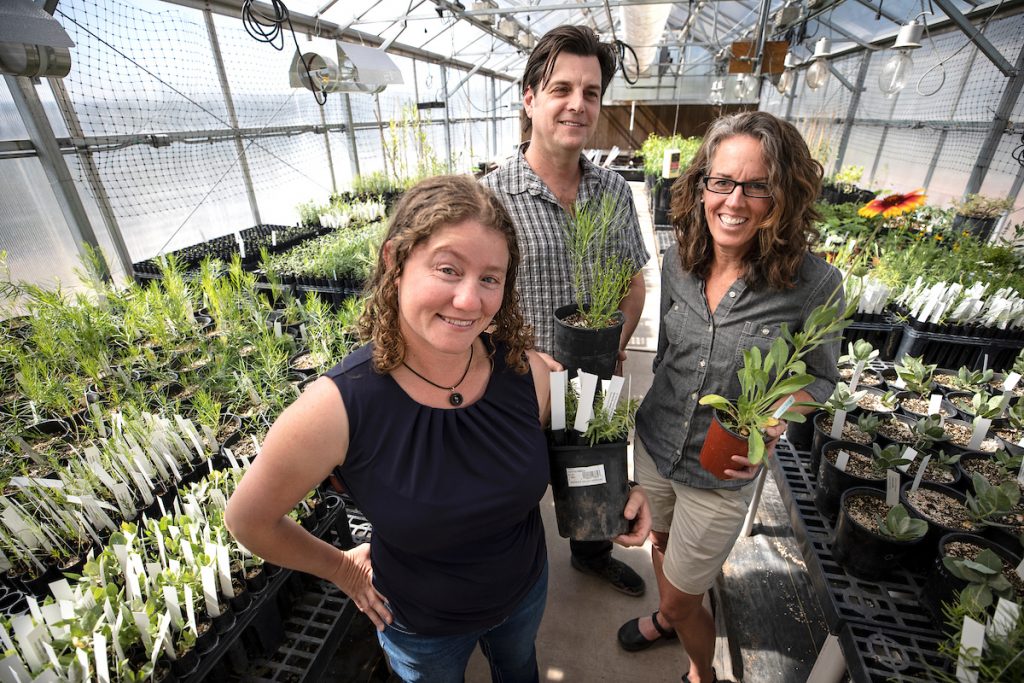By Kerry Bennett and Julie Hammonds
Office of the Vice President for Research
Not long ago, Kevin Grady, assistant research professor of forestry at Northern Arizona University, was involved in the emergency response to a 30,000-acre wildfire. Land managers he worked with wanted to jump-start restoration immediately. Grady figured covering that many acres with plants would require 90 semi-trailer trucks full of seeds—seeds that weren’t easy to find. He asked himself, “What can we learn and share so land managers can do a better job of restoration?”
As climate change brings more severe, more frequent wildfires and droughts throughout the western United States, land managers are increasingly challenged to find the best restoration approaches—and the right kinds of seeds to plant for successful outcomes. At the same time, pollinators such as bees, birds and butterflies are in decline, which poses a major threat to both conservation and agriculture.
A cross-disciplinary team of NAU ecologists recently received a five-year, $935,000 grant from the U.S. Department of Agriculture to study which plants are most fit for restoring damaged lands and capable of supporting diverse pollinator communities.
Study to identify foundation species for crisis events and large-scale restoration
Grady—along with Clare Aslan, assistant professor of earth sciences and environmental sustainability, and Karen Haubensak, assistant research professor of biology—launched the ambitious project, which is designed to identify the foundation species best suited for seed production for crisis events as well as for large-scale restoration.
“There is a critical need to restore plants and pollinators that are essential for promoting diversity and ecosystem services important to human communities,” said Grady, the project’s principal investigator.
The scientists will test nearly 50,000 plants of 12 species—the largest trial of its kind in the western region. Based on the outcome of the test, they will conduct a trial of 105,000 plants at established small farms to identify growing conditions that optimize seed production.
“We want to know which plants support diverse pollinators, produce lots of seeds and perform best in large-scale restoration projects,” Haubensak said.
The goal is to use the right plants in the right combinations, while bolstering native seed production throughout the region.
“Maintaining and restoring functionally diverse pollinator communities, using a seed supply that is abundant and well-suited to current and future conditions, is essential to the long-term success of restoration investments,” Aslan said.
Testing climate factors on plant performance
“When land managers restore an area after a fire, there’s typically not enough native seed on hand,” Grady said. “They’re getting seed from all over, and it’s generally 60 percent exotic rather than native.”
Furthermore, because land managers typically don’t consider how well the plants will be doing in 25 or 50 years, these restorations could fail in the long term because they don’t take climate change into account.
This study will use a technique called a provenance trial, which is a test of how climate factors affect plant performance.
“A provenance trial involves taking seeds from varied locations, or provenances, and putting them in a common garden to test environmental versus genetic effects on plant-insect interactions and plant performance,” Grady said.
The trial will use common gardens in Flagstaff and Cottonwood; Moab, Utah; and Albuquerque, New Mexico, to test the 12 species. The four locations create a climate gradient, generating a range of data to support more effective, species-specific seed zone guidelines.
Focus on plant-pollinator relationships critical to project
The emphasis on pollinators is a critical aspect of this project. Fires and climate change can directly impact bees and other insect pollinators or reduce their forage plants, decreasing the overall nectar supply across broad landscapes. Aslan, a pollinator expert, will focus on plant-pollinator relationships.
“Looking at how well these plants form pollination relationships will help us decide whether to recommend them as restoration species,” she said.
Grady’s research focuses on several key themes, including assisted migration, facilitation, carbon cycling, biodiversity, pollination, co-evolution, exotics and climate change. Aslan, associate director of the Landscape Conservation Initiative, is interested in the ecology and conservation of species interactions and how dynamics at the interaction level can scale up to the full community level. Haubensak is with the Center for Ecosystem Science and Society. She examines interactions and feedbacks among soils and plants to understand how terrestrial ecosystems respond to stressors like climate change and invasive species.



